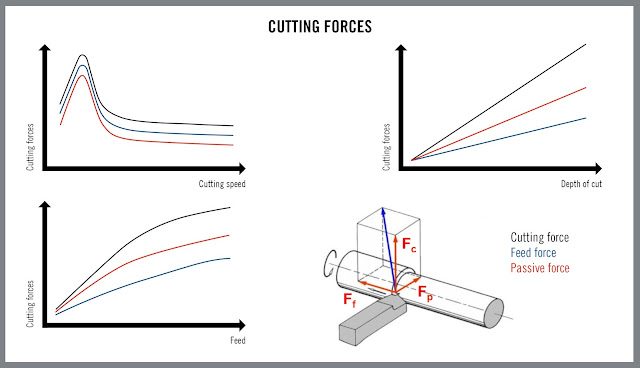 Tribology is a relatively new area of metalcutting load analysis. It studies how surfaces in contact with each other, such as the cut chip and tool, interact at certain temperatures and pressures. Its main focus is e.g. learning what causes the negative phenomenon of built-up edge and what can be done to minimize the problem.
Tribology is a relatively new area of metalcutting load analysis. It studies how surfaces in contact with each other, such as the cut chip and tool, interact at certain temperatures and pressures. Its main focus is e.g. learning what causes the negative phenomenon of built-up edge and what can be done to minimize the problem.Tribological research has determined that the cutting process does not simply involve a single shearing event and subsequent disconnection of chip and tool. In fact, secondary and tertiary connections and disconnections also occur. The chip shears away, adheres to the rake face and then shears away again before finally sliding off the tool. The main wear mechanism is repeated shearing, not friction.
Built-up edge occurs when thin layers of the workpiece material adhere to and build-up on the tool rake face. If a significant amount of material accumulates on the tool, it can change the profile of the cutting edge. The built-up material can also break off and damage the edge or be deposited on to the workpiece. Regardless, edge buildup makes the cutting process unpredictable and results in poor surface finishes and a need to change tools frequently.
We know that the prime factors that promote edge buildup are high ductility, high adhesion tendencies, abrasiveness and the high pressure and temperatures that are generated when machining tough alloys that have poor thermal conductivity. The possibility of built-up edge formation is much greater in newer workpiece materials such as low carbon steels, aluminum, and the family of aerospace and energy industry materials encompassing titaniums, nickel-based alloys and heat-resistant metals.
Tooling engineers are applying the findings of tribological research in the development of machining processes and tools that will meet the higher demands from these new materials. On the process side, we know that minimizing adherence and the chances for forming built-up edge involves reducing the contact time between the chip and the rake face.
The most straightforward solution is to increase the cutting speed and apply a sharper tool. Faster cutting speeds reduce the time the tool and workpiece material are in contact with each other. The resulting higher process temperatures can also reduce the strength of any edge buildup or eliminate it entirely. The sharper tool has a higher primary rake angle that forces the chip to move more quickly. Other tool geometry choices, such as use of positive rake tools, can help direct cut material away from the workpiece.
We have also used tribology research findings to understand the role tool coatings play in minimizing edge buildup. For example, the newest generation of Seco’s CVD aluminium-oxide Duratomic® coating is based on tribological principles. Development engineers manipulated coating components in response to expanded knowledge of the interactions between the chips and the cutting tool.
Another example of Seco coatings aimed at controlling built-up edge is the new silver PVD uni-coating developed for MS2050 milling inserts. The coating has high heat resistance capabilities and also practically eliminates the occurrence of built-up edge when cutting sticky materials such as titanium. With the absence of built-up edge, the inserts last about 50 percent longer and run at much higher cutting parameters as compared with existing tools.
Tool engineers are also using tribology to research ways to turn edge buildup from a liability into a positive contributor to machining productivity. For example, in some cases, a thin layer of workpiece material on the surface of the cutting tool actually slows the progress of wear. The key is to find a perfect thickness of this tool protection layer that does not affect tool geometry and also does not separate from the tool surface.
While tribology may not be a topic you think about everyday, it is offering an important new perspective for developers of cutting tools and machining processes. It’s giving us another tool to use as we respond to and solve increasingly tougher machining challenges in innovative ways.
If you have questions about tribology, please contact me.
 About the Author
About the AuthorBased in The Netherlands, Patrick is the corporate technical education manager for Seco Tools AB with global responsibilities for the technical education activities that help train Seco employees and customers worldwide. He led the creation of the Seco Technical Education Program (STEP) and since its launch more than 200,000 people worldwide have participated in the program. He has been with the Seco organization for more than 30 years, and during that time he has trained more than 70,000 people in over 57 countries. He is also the author of the books “Metal Cutting, theories in practice”, “Tool Deterioration, Best Practices” and “Applied Metal Cutting Physics, Best Practices”.










